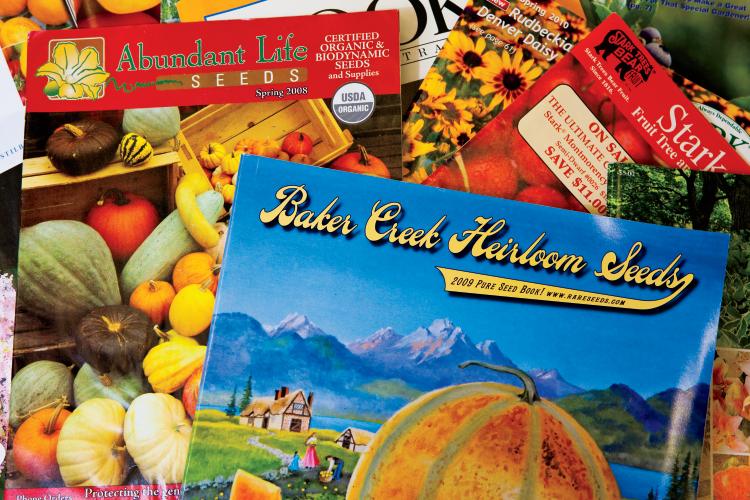Seed Catalog Tips From a Master Gardener
Right around the time when we have just finished putting our garden to bed for the winter, spring seed catalogs begin arriving.

The excitement of seeing the new varieties offered, checking on an old favorite or finding the unusual plant not available in our area makes reading the catalogs a treat.
We gardeners are an optimistic bunch. Never daunted by past failures, we are eager to once again try a new variety of vegetable, a unique shrub or an easy-to-maintain flower.
Ordering from reliable companies, such as Burpee, will ensure you get good-quality plants. While we are all tempted by catalogs that offer “real deals” for “only 99 cents,” some offerings are excellent buys, but most are a disappointment. All companies will give you new plants if the originals do not survive – that is, if you can find your receipt and whatever else they require. Any time we order and a plant fails, we lose a whole growing year.
When you’re thinking ahead to the 2011 growing season, it is also an excellent time time to review the last one. Were those cucumbers as good as advertised? Did those tomatoes that were heralded to produce a large crop do as promised, but produce a crop that tasted like hothouse tomatoes? What is your preference on tomatoes: a high-acid, flavorful tomato like Rutgers, a low-acid yellow or something in between?
A huge flower success for me was a winter-hardy native hibiscus, Hibiscus moscheutos. It produced 8- to 12-inch white blooms (also available in pink, red or purple) with red centers from midsummer to frost. It grows in sun or part shade, 2 to 12 feet tall, 2 to 4 feet wide, without special care.
Why doesn’t my hydrangea boom? Wish I had a dollar for every time I get that question. There are many kinds of hydrangea, so the problem could be too much sun or too much shade, or you could have trimmed off the blooming branches. Try Hydrangea paniculata “Limelight”; it will not disappoint you. This shrub has 6- to 12-inch panicles of chartreuse flowers that slowly change from mauve pink to burgundy in the fall. It grows in sun to part shade, 3 to 25 feet tall, 8 to 16 feet wide.
After perusing the catalog offerings, it will be time to start those seedlings before you know it. Do as your grandparents did and try planting the seeds you saved from your biggest and best plants for your garden.
For now relax, enjoy and use the seed catalogs to research and help plan your new garden. It is exciting and inspiring to look at all those glorious photos!













 My Indiana Home is produced for Indiana Farm Bureau members. Our mission is to connect you with the food you eat, the Indiana farmers who grow it and a rural lifestyle that is uniquely Hoosier.
My Indiana Home is produced for Indiana Farm Bureau members. Our mission is to connect you with the food you eat, the Indiana farmers who grow it and a rural lifestyle that is uniquely Hoosier.
Judy Herring
November 30, 2011 at 11:10 am
I have a Mandevillia plant that bloomed nicely for a while when I had it outside on the south side of the house. All of a sudden it lost it’s flowers and died. I brought it in when the weather started getting cold and thought I could revive it, but it’s just a stick now. What did I do wrong? This makes the second one of these I’ve had and they both did the same thing.
Jessy, editor of My Indiana Home
December 2, 2011 at 8:21 am
Judy, here is the scope of Mandevilla, courtesy of our master gardener, Colletta Kosiba. Hope this helps!
Mandevilla: Native to Central and South America a tropical vine prized for trumpet-shaped blooms and attractive green foliage. They tolerate temperature in the range of 70 to 85 degrees. Minimum temperatures tolerated are 45-50(time to move in the house)
Where to plant: Mandevilla vines need some shade. They enjoy bright indirect or filtered sunlight, but can get burned in direct, full sunlight.
Use a well-drained soil (very sensitive to over watering). Allow plants to dry between waterings, which means do not water every day. When you water, make sure you water thoroughly. water —– S L O W L Y —- so all of the soil gets wet. (to 3” depth)
Fertilizing high phosphorus, water soluble fertilizer once every two weeks. keeps mandevilla vine blooming wonderfully.(no fertilizing in the winter months as the plant is dormant state )
Pinch mandevilla to create a bushier and fuller plant. Simply use your fingers to pinch off 1/4 – 1/2 inch off the end of each stem.
Herbicidal drift will kill plant.